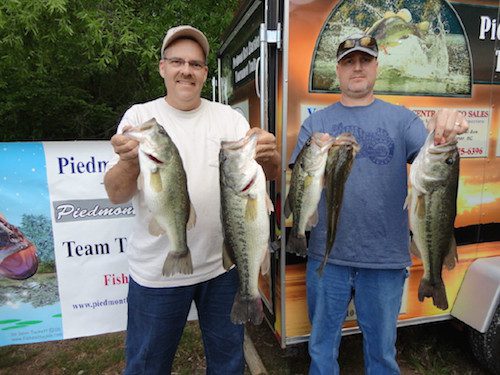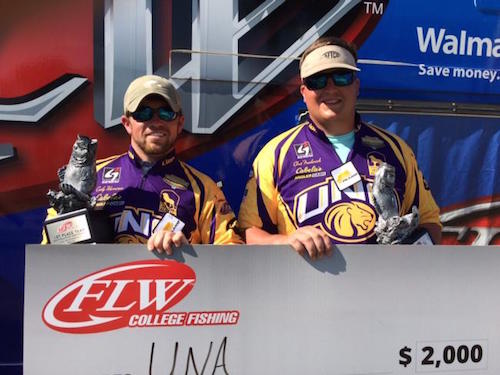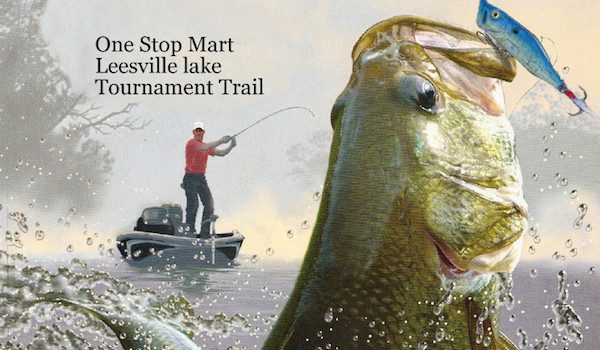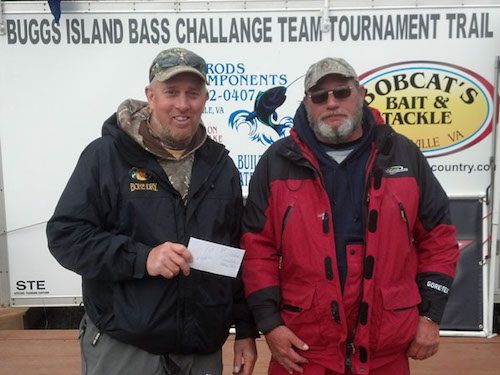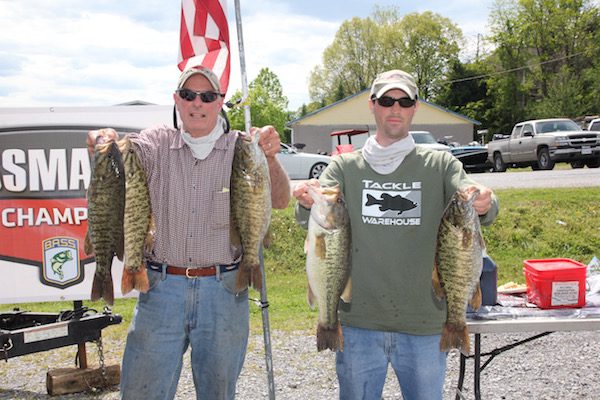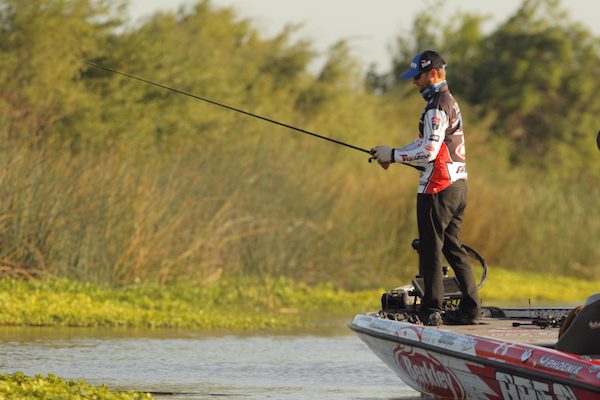ADERHOLD WINS WALMART BASS FISHING LEAGUE BAMA DIVISION EVENT ON LOGAN MARTIN LAKE
Kevin Strickland & Ron Nelson Win Tobacco Bass Invitational Tournament May 2nd 2015
TOBACCO BASS INVITATIONAL TOURNAMENT
May 2nd, 2015~~KERR LAKETa
FLEMINGTOWN LANDING WILDLIFE RAMP
[print_link]
For complete results & pics…. http://piedmontbassclassics.com/TobaccoBass.html
Results for the 32 Teams: Had a great turnout this year! The weather was great and the bite was excellent. Most every team weighed in a fish. 111 bass made it to the scales for a total weight of 273 pounds! Big fish for the day was 5.23 lbs and all the fish looked healthier than ever! Most all fish were caught on spinnerbaits, jerk baits, finesse worms and crankbaits. Water temps averaged 65 degrees.
Kevin Strickland & Ron Nelson took top honors this year with 5 bass weighing 17.10 lbs. and took home $830 in winnings. 2nd Place went to the team of Randy & David Marshall with 5 weighing 15 lbs. & $485 in prize money. Big fish for the day (5.23 lbs.) was caught by the 4th place team of Jody Cook & Jerry Brown giving them a total winnings of $573!
Once again, I had a great time as your director and look forward to next year.
Give Kevin a call and let him know if there is another lake you would like to fish in 2016 and we’ll make a decision based on your input. Thanks again! Phil McCarson~Tournament Director (ps: Thank you
Evans-MacTavish Agricraft in Wilson & Caraway Creek Custom Baits in Sophia & EZ Bait & Tackle in
Goldsboro for your donations to the Tobacco Bass Event!)
Here are the results:
1st Place
Kevin Strickland (Lorillard) & Ron Nelson
5 fish…17.10 lbs…$830
2nd Place
Randy Marshall (Lorillard) & David Marshall
5 fish…15.00 lbs…$485
3rd Place
Michael & David Mitchell (Evans MacTavish Agricraft)
5 fish…14.80 lbs…$345
4th Place
Jody Cook (Liggett) & Jerry Brown
5 fish…14.75 lbs…$253
5th Place
Tommy Blythe & Glenn Denham both from Lorillard
5 fish…14.39 lbs…$207
6th Place
Elton Clements (American) & Rick Clements
5 fish…14.38 lbs…$184
Big Bass Award…….4th Place Team Above…5.23 lbs…$320
AND TOURNAMENT REMINDER FOR THIS COMING SATURDAY AT JORDAN!!!
ANOTHER LARGE CROWD IS EXPECTED!!!
**Sat. May 9th, 2015 ~ Piedmont Bass Classics $10,000 Spring Team Trail Q#6
Jordan Lake ~ Farrington Point Wildlife Ramp (Directions)
For Rules & Entry Form Click Here I will be at the ramp by 3:45am to sign you in.
Get there early !! Blastoff will be approximately at 5:45am & weighin at 3:00pm 1st Flight
If you have fished only 2 qualifers as a team, you must fish the last 2 as a team to qualify
for the Championship June 13th at Falls Lake.
MOTHER’S DAY IS COMING THIS SUNDAY MAY 10TH !!!
WE HAVE NUMEROUS SPONSORS THAT HAVE JUST THE RIGHT
GIFT FOR YOUR MOM OR YOUR KIDS MOM!!!
JUST THINK ABOUT IT!!!
A NEW HONDA FROM CROWN HONDA OF SOUTHPOINT IN DURHAM!
JEWELRY OR OUTDOOR CLOTHING FROM WT’S IN GOLDSBORO, OVERTON’S IN RALEIGH,
A NEW PONTOON BOAT FROM CHATLEE IN SANFORD OR MERRITT MARINE IN HILLSBOROUGH!
A NEW ROD & REEL FROM ANY OF OUR GREAT TACKLE SHOPS LISTED ON THE WEBSITE. AND THE
LIST GOES ON! GET THE MOTHERS SOMETHING THEY ARE NOT EXPECTING THIS YEAR AND
OUR GREAT SPONSORS CAN HELP!!! PLEASE SUPPORT THEM BECAUSE THEY SUPPORT US!!!
Thanks for fishing with Piedmont Bass Classics!
Let us help grow your business!
If you would like to sponsor or help sponsor any of our tournaments give me a call.
Contact Information:
Phil McCarson…Tournament Director—922 Valetta Rd.—Durham, NC 27712
Home: 919-471-1571 Cell: 919-971-5042
email: [email protected] website: http://piedmontbassclassics.com/
Check out all of our Great Sponsors Click Here!
Our Sponsors Support Us…….So…….Please Support Our Sponsors!
See ya Saturday!! Phil
Chris & H.T. Eakins Win Piedmont Bass Classic $10,000 Spring Team Bass Trail Qualifier #5 April 25th 2015
PIEDMONT BASS CLASSICS $10,000 SPRING TEAM BASS TRAIL QUALIFIER #5 RESULTS
Saturday April 25th, 2015 ~ Kerr Lake ~ Flemingtown Landing Wildlife Ramp
[print_link]
Another huge turnout for the PBC Qualifer #5 at Kerr Lake. Temps in the am were around 44 and up to about 64 in the afternoon and winds were 5 to 10. Water temps averaged 65. Out of the 86 teams that fished 61 caught their limits of 5. It was a great day for fishing with cloudy skies and light rain. Chris & H.T. Eakins topped the tightly contested weights coming in with 5 bass weighing 18.71 lbs. and won the 2nd Place Big Fish (5.35 lbs.) earning them a total of $1,955 in prize money! Ernest Warren took 2nd place with 5 weighing 17.97 lbs and pocketed $845. Other big winners were the tied 3rd place & 1st Place TWT team of Glenn Elliott & Stump Bledsoe who picked up $2,027. The 8th place team of Troy Horne & Daryl Peele also won the 1st Place Big Fish Award and took home $1,509 in prize money!!! The prize money, again, got spread around giving quite a few teams a nice payday!!!
349 fish were weighed in for a total of 917 pounds for an average of 2.63 lbs. each. The water was up at Kerr(302), the water was in the bushes and the bite was fantastic! Most of the fish were caught flipping plastics & jig combos. The bass were hitting about anything!! Spinnerbaits, crankbaits & chatterbaits also loaded the livewells.
I want to thank all the anglers that participated and all our sponsors that support this trail.
Coming up May 9th will be the Piedmont Bass Classics $10,000 Spring Team Bass Trail Qualifier #6 at Jordan
Lake out of Farrington Point Wildlife Ramp.
All the information on our tournaments can be found http://piedmontbassclassics.com/
Now here are the full results:
1st Place: Chris & H.T. Eakins of Selma & Angier…5 bass…18.71 lbs…$1,445
2nd Place: Marty Warren of Elon…5 bass…17.97 lbs…$845
3rd PlaceA: Stump Bledsoe & Glenn Elliott of Hope Mills & Fayetteville…5 bass…17.78 lbs…$752 (Tie)
3rd PlaceB: Mike Eggers & Mark Willis of Garner…5 bass…17.78 lbs…$752 (Tie)
5th Place: Keith Deal & Ricky Kenworthy of Holly Springs & Cary…5 bass…17.36 lbs…$526
6th Place: Mike Hodge & Johnny Woods of Clayton & Angier…5 bass…16.28 lbs…$458
7th Place: Blake Cobb & Daniel Jenkins of Burlington…5 bass…16.03 lbs…$393
8th Place: Troy Horne & Daryl Peele of Goldsboro…5 bass…16.00 lbs…$319
9th Place: Jaime Fajardo & Dan Jackson of Fuquay Varina…5 bass…15.95 lbs…$278
10th Place: Bud Whitt & Spencer Moody of Staley & Siler City…5 bass…15.70 lbs…$244
11th Place: Dave Murdock & Tony Fofi of Sanford & Spring Lake…5 bass…15.46 lbs…$208
12th Place: Bobby & David Matthews of Durham & Creedmoor…5 bass…15.44 lbs…$198
13th Place: Tim Spainhour & Schonn Denny of Climax & Julian…5 bass…15.23 lbs…$183
14th Place: Sam & Matthew Jones of Clayton…5 bass…15.15 lbs…$139
15th Place: Robbie & Gurney Hoffman of Jacksonville & Richlands…5 bass…14.96 lbs…$134
16th Place: Jesse Wise & Terry Hobbs of Erwin & Garner…5 bass…14.79 lbs…$130
17th Place: Thomas Sheffer & Ken McNeill of Cary & Raleigh…5 bass…14.64 lbs…$125
1st Place Big Fish..8th Place Team above…5.42 lbs…$1,190
2nd Place Big Fish..1st Place Team above…5.35 lbs…$510
1st Place TWT..3rd PlaceA Team above…17.78 lbs…$1,400
2nd Place TWT..5th Place Team above: 17.36 lbs…$600
Tow Boats US Award: Marty Warren of Elon $50.
Bass Pro Shops Nitro Boats Tournament Rewards..Daryl Peele of Goldsboro $500.
And Coming Soon!!!
**Sat. May 9th, 2015 ~ Piedmont Bass Classics $10,000 Spring Team Trail Q#6
Jordan Lake ~ Farrington Point Wildlife Ramp (Directions)
For Rules & Entry Form Click Here I will be at the ramp by 3:45am to sign you in.
Get there early !! Blastoff will be approximately at 5:45am & weighin at 3:00pm 1st Flight
**Sat. May 16th, 2015~~Cashion Fishing Rods Spring Team Trail Final Q#5
Jordan Lake ~ Farrington Point Wildlife Ramp (Directions)
For Rules & Entry Form Click Here I will be at the ramp by 4:45am to sign you in.
Blastoff will be approximately at 5:45am & weighin at 3:00pm 1st Flight
UNIVERSITY OF NORTH ALABAMA WINS FLW COLLEGE FISHING SOUTHEASTERN CONFERENCE EVENT ON LAKE GUNTERSVILLE
Mike Thomas & Taylor Thomas Win Leesville Lake Tournament Trail May 3-2015
We had 22 boats on May 3 at Leesville Lake. Results are:
1st Place-Mike Thomas/Taylor Thomas-5 fish-20.24 lbs.
2nd Place-Don Wheeler/Billy Strain-5 fish-18.63 lbs.
3rd Place-Matt Kluender/Mark McFadden-5 fish-17.23 lbs.
4th Place-Seth Brogan/Hunter Tolley-5 fish-14.48 lbs.
Big fish of the day-Garrett Waterman/Josh Lambert-a 5.47 lb. largemouth
Lucas Gets Career Victory No. 1 In Front Of Big Home Crowd
|
|
|
|
Davies & Shawler Win Bobcats Bass Team Trail April 26, 2015
2015 4rd Annual Bass Team Tournament Trail
Hosted by: Brandon Gray Local Lure Adventures
April 26, 2015 – Results – Kerr Lake – Occoneechee
(Pictures Below)
CLICK HERE FOR CURRENT POINT STANDINGS
|
Place
|
Boat #
|
Team |
Weight
|
Payout
|
|
1
|
10
|
Davies/Shawler |
17.34
|
$1,256.64
|
|
2
|
20
|
Szuba/Woodard |
16.62
|
$658.24
|
|
3
|
30
|
Marrow/Reedy |
16.60
|
$359.04
|
|
4
|
19
|
Hardy/Meadows |
15.24
|
$269.28
|
|
5
|
28
|
Doughtie/Cashwell |
15.22
|
$239.36
|
|
6
|
3
|
Elder/Bomar |
15.03
|
$209.44
|
|
7
|
33
|
Crisman/Slayton |
14.71
|
|
|
8
|
12
|
Roberts/Cooper |
14.67
|
|
|
9
|
2
|
Young/Hubbard |
14.53
|
|
|
10
|
8
|
Purcell/Purcell |
14.48
|
|
|
11
|
34
|
Rigney/Beale |
14.02
|
|
|
12
|
27
|
Gilbert/Foster-sub |
13.66
|
|
|
13
|
23
|
Rigsbee/Herndon |
13.12
|
|
|
14
|
13
|
Houchins/Houchins |
12.89
|
|
|
15
|
24
|
Griggs/Wall |
12.65
|
|
|
16
|
16
|
Grant/Stallings |
12.53
|
|
|
17
|
18
|
Haywood/Sharp |
12.49
|
|
|
18
|
14
|
Nealy/Ball |
11.89
|
|
|
19
|
9
|
Stanton/Stanton |
11.65
|
|
|
20
|
29
|
Owen/Talbot |
11.24
|
|
|
21
|
6
|
Winn/Nichols |
10.08
|
|
|
22
|
21
|
Samples/Lopez-sub |
9.26
|
|
|
23
|
15
|
Royston/Reid sub |
8.93
|
|
|
24
|
25
|
Warren/Jenkins |
8.69
|
|
|
25
|
11
|
Smith/Hensley |
8.41
|
|
|
26
|
5
|
Elliott/Compton |
6.87
|
|
|
27
|
17
|
Bowen/Sharp-sub |
6.87
|
|
|
28
|
1
|
McKinney/Eldridge |
6.52
|
|
|
29
|
32
|
Fiddle/Walker |
4.86
|
|
|
30
|
4
|
Jackson/Patterson |
3.38
|
|
|
31
|
7
|
Moore/Henshaw |
0.00
|
|
|
32
|
22
|
Colwell/Roller |
0.00
|
|
|
33
|
26
|
Jenkins/Jenkins |
0.00
|
|
|
34
|
31
|
Reynolds/Reynolds |
0.00
|
|
| Team |
Big Fish
|
Payout
|
||
|
1
|
Davies/Shawler |
5.81
|
$408.00
|
|
|
2
|
Doughtie/Cashwell |
4.74
|
$272.00
|
 1st place – Davies/Shawler |
 2nd place – Szuba/Woodard |
 3rd place – Marrow/Reedy |
 4th place – Hardy/Meadows |
|
|
Jeffrey & Clay Ross win Angler’s Choice Team Tournament Trail Stop 5 on SML May 2nd 2015
1st Place Jeffrey & Clay Ross with five fish weighing 18.57lbs.
2nd Place Thomas Wooten & Gregory Scott with five fish weighing 17.86lbs.
3rd Place Ryan & Wayne Mace with five fish weighing 17.67lbs.
CLICK HERE TO SEE RESULTs
CLICK HERE TO SEE POINTS STANDINGS
2nd Place Thomas Wooten & Gregory Scott with five fish weighing 17.86lbs.
3rd Place Ryan & Wayne Mace with five fish weighing 17.67lbs.
CLICK HERE TO SEE RESULTs
CLICK HERE TO SEE POINTS STANDINGS
2nd Place Thomas Wooten & Gregory Scott with five fish weighing 17.86lbs.
3rd Place Ryan & Wayne Mace with five fish weighing 17.67lbs.
CLICK HERE TO SEE RESULTs
CLICK HERE TO SEE POINTS STANDINGS
3rd Place Ryan & Wayne Mace with five fish weighing 17.67lbs.
CLICK HERE TO SEE RESULTs
CLICK HERE TO SEE POINTS STANDINGS
3rd Place Ryan & Wayne Mace with five fish weighing 17.67lbs.
CLICK HERE TO SEE RESULTs
CLICK HERE TO SEE POINTS STANDINGS
CLICK HERE TO SEE RESULTs
CLICK HERE TO SEE POINTS STANDINGS
Lucas In Position For Career-Defining Victory
Justin Lucas of Guntersville, Ala., takes the lead on Day 3 of the Sacramento Bassmaster Elite at Sacramento River. He has a three-day total of 66 pounds, 14 ounces.
Lucas In Position For Career-Defining Victory
[print_link]
SACRAMENTO, Calif. — Justin Lucas knows he’s on the verge of something special.
But with the way fish are behaving on the California Delta, he knows he still has plenty of work to do if he’s going to raise the coveted blue trophy and pocket a $100,000 check in front of a crowd filled with his family and friends Sunday afternoon.
A native Californian who now lives in Alabama, Lucas caught five bass Saturday that weighed 19 pounds, 3 ounces and took the lead in the Sacramento Bassmaster Elite at Sacramento River with a three-day total of 66-14.
Lucas will lead the Top 12 remaining anglers into Sunday’s championship round with a pair of fellow California natives in close contention. Aaron Martens — who like Lucas, grew up in California and relocated to Alabama — is in second with 63-14, followed by San Jose, Calif., resident Chris Zaldain with 60-12.
“It could have been a lot worse, but it could have been better, too,” said Lucas, who has been running down the Sacramento River each day to the California Delta past landmarks he remembers seeing on his way to school as a child. “I had a 6-pounder that bit a couple of times, and I just wasn’t quick enough to get her. After she got it twice and I missed her, she just never would bite again.
“I only caught five or six keepers all day. It wasn’t an easy day by any means.”
Lucas pushed his way into serious contention during Friday’s second round by turning to areas that were good to him more than a decade ago — areas he hadn’t fished in practice. On Saturday, he fished those areas, plus a few more new ones.
He expects to fish more new water Sunday, while still targeting shallow spawners and postspawn bass.
“I’ve been pounding some of these areas pretty hard this week, and I just feel like I’ve got to find new stuff,” Lucas said. “My weight was lower today than yesterday, and I hate that. I want my weights to go up and feel like I learned something.”
Though Lucas didn’t have the day he was hoping for, he fared better than the anglers who began Saturday in first and second place.
Day 2 leader Aaron Martens started his morning with a 6-pounder. But things went steadily downhill from there, and he brought in just 12-10.
“When you get a big one early like that, it can be a good thing or a bad thing,” Martens said. “I don’t know if it affects the way you think the rest of the day or what.”
More than the possible bad mojo created by landing a big fish early, Martens believed he was hurt by unfavorable tidal conditions.
“We’re just not even close to the tide being right, as far as I’m concerned,” Martens said. “The tide is actually good in the morning. But it’s been cold in the mornings, and the fish just don’t want to bite.”
Zaldain was also frustrated by the tide Saturday as his weight plummeted from a whopping catch of 30-7 Thursday and a solid mark of 20-7 Friday. With only 9-14 Saturday, he fell in the standings for the second straight day.
After making a 90-minute run to the Delta the first three days of the event to fish for bedding bass, Zaldain plans to run even farther Sunday toward his old hometown of San Jose.
“Catching 30 pounds on the first day kind of gave me a get-out-of-jail-free card,” Zaldain said. “I used that card big-time today.”
By making a longer run Sunday — he estimated it will take nearly two hours each way — Zaldain hopes to get ahead of the tide for more favorable conditions. The right tide, he said, will make shallow spawning fish more cooperative.
“The last three days, I’ve fished one area in the north Delta,” Zaldain said. “Tomorrow, if I head as far south as possible — as far away from the Golden Gate Bridge as I can get — I think I can find some high water.
“All through practice, I had really good high-tide bites. That’s what I need to find Sunday.”
No one else cracked the 60-pound mark for the week on Saturday. But with so many big fish cruising the shallows of the California Delta, most of Sunday’s championship qualifiers are still within realistic striking distance of a come-from-behind win.
Behind Lucas, Martens and Zaldain, the rest of the Top 12 is as follows: Dean Rojas (59- 7), Bobby Lane (59-5), Ish Monroe (59- 4), Ken Iyobe (59- 1), Tim Horton (58-3), Jason Christie (56- 5), Cliff Pirch (55-12), Keith Combs (55- 3) and Chris Lane (54- 7).
Horton jumped into contention with the biggest catch of the day with weighing 20-12.
The tournament will conclude Sunday with take-off set for 6:15 a.m. from Discovery Park and weigh-in scheduled back at the park at 3:15.
The Elite Series Expo will be open at noon on Sunday and will have B.A.S.S. sponsor representatives onsite throughout the weekend with activities, games and prizes for attendees including boat demo rides.
Other activities planned throughout the Bassmaster Elite at Sacramento River weekend include a Kids Zone, angler autograph and photo sessions, and the chance to learn tips and techniques from some of the best bass anglers in the world.








